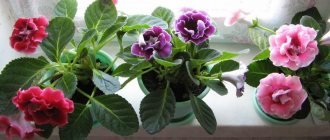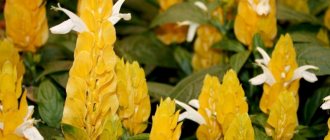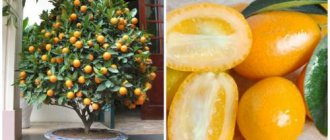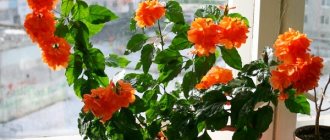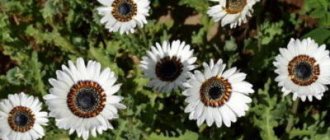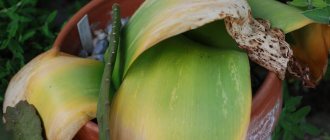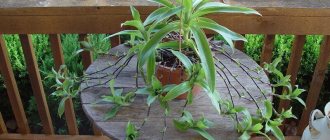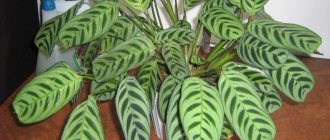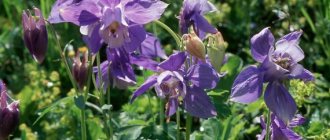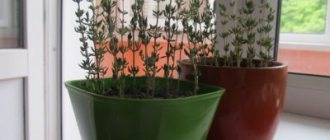Growing lemon eucalyptus from seeds
The culture can be propagated by cuttings and seed method. The permissible sowing time is quite long: from mid-February to the end of June. But planting from the third ten days of February to the second ten days of April is considered optimal.
For cultivation, you should use turf soil with sand in equal proportions, which must be prepared in advance. For sowing, use standard containers with drainage, such as ordinary flower pots, or cups for seedlings with stands.
Preparing to plant lemon eucalyptus seeds
Seeds are planted to a depth of 5 millimeters, 2-3 pieces per container. After sowing, it is recommended to cover the pots with plastic wrap or a bag - this will help retain moisture in the soil. Check the soil surface daily and moisten when dry.
Eucalyptus seeds germinate quite quickly, but provided that the room temperature is kept between 23-25 degrees Celsius. The first shoots can be noticed within a week after sowing, but pipping can take up to three months.
Eucalyptus seeds germinate quickly and seedlings need to be picked
This plant needs picking. It is performed when the first 2 true leaves appear. Seedlings are planted one at a time in a container with a diameter of 7 centimeters. Before planting, prepare the soil by mixing turf soil, humus and sand in a one to one ratio.
Varieties suitable for home cultivation
How to grow a lemon tree from a seed at home
There are many types of eucalyptus (more than 500), but only a few of them are suitable for growing as an ornamental crop. The most popular include:
- globular. It stands out for its beautiful, pyramidal crown and bluish-blue leaves, on the outside of which there is a silvery coating;
- Gunny. Young plants have round, gray-green leaves, which become oblong with a pointed tip as the tree matures;
- Blue baby. Belongs to the dwarf species of eucalyptus. Distinguished by small gray-blue petals;
- fig leaf. It stands out among other varieties due to its rounded small leaves;
- silver or ash. The main difference is the gray oval or round leaves;
- Populus is an ornamental eucalyptus that is capable of forming small berries.
Important! These varieties are not intended for planting in open ground; they can only be grown indoors.
There is also a very beautiful species, the rainbow eucalyptus, which has bark of various colors similar to a rainbow, but it is not suitable for growing as a houseplant.
Varieties of plants in pots on the windowsill
Flowering and fruiting of a eucalyptus tree
Flowering in eucalyptus trees begins from 2 to 10 years. Flowering usually occurs in late spring or early summer, but there are differences depending on the type of eucalyptus. The buds usually appear first, and then over the course of three months they begin to gradually open. They also experience fruit ripening. Ripening usually lasts one year, maybe a little longer, depending on the climate. Seeds ripen in the fruits. Seeds can be planted for ten years; they retain their viability for a very long time. There are cases when seeds are stored for forty to fifty years.
Caring for eucalyptus at home
This culture loves warmth and light, so you should think in advance about the location of the pots with seedlings. Until the plant gets stronger and actively develops, it is necessary to create the following conditions:
- temperature not less than 24 degrees Celsius;
- increased air humidity of at least 65% in winter, and 60% in summer.
To prevent the eucalyptus from getting sick, it is necessary to harden it.
To prevent the plant from getting sick, it is necessary to harden it. This can be done in warm weather, but it is important to avoid drafts. In winter, the permissible temperature for keeping the plant is up to 16 degrees Celsius.
Temperature
Eucalyptus is a houseplant, and for good growth it needs a certain temperature and humidity. In summer, the temperature should be maintained above +20 ºC, in winter it should be reduced and the tree should be kept cool.
Important! In spring and summer, you can take the pot with the plant to an open area.
Formed eucalyptus
Lighting
The culture loves light and this must be taken into account when placing pots. The best growing zone is south, east and southeast. The lack of sunlight can be compensated by using fluorescent lamps.
In summer it is useful to expose eucalyptus to sunlight, but it is important to be careful not to cause a burn. The plant should be accustomed to natural sunlight gradually.
Priming
The most favorable soil composition:
- humus – 1 part;
- turf soil - 1 part;
- river sand – 1 part.
You can use universal purchased soil.
Watering and air humidity
Watering eucalyptus during the period of active growth should be plentiful. In winter, the amount of water is reduced and the time between watering is increased. When caring for a plant, you should not go to extremes. It should be understood that both drying out of the soil and its excessive moisture are dangerous for it. Excessive watering can lead to root rot and subsequent death of the plant.
It is recommended to water eucalyptus with settled water at room temperature.
Lemon eucalyptus is a plant that needs constantly moist air, especially on hot sunny summer days. Eucalyptus reacts very poorly to spraying. The most optimal way to maintain humidity is to place the pot on a specially designed tray that has constantly moistened drainage.
Top dressing
The culture actively develops from spring to autumn, and winter is a dormant period. During this period, it is recommended to add organic matter and mineral fertilizers. Fertilizers are applied every 14-20 days, and stop in winter.
Soil and replanting
Indoor lemon eucalyptus at a young age requires annual replanting. Adult specimens are replanted every 2-3 years. Eucalyptus does not tolerate this procedure very well, so it is better to transplant it into a larger pot by transshipment, which will help avoid damage to the root soil.
When replanting plants over 3 years old, the roots are pruned. Garden varnish is used to lubricate the cuts.
The soil for lemon eucalyptus should be quite loose. The composition of the soil usually includes turf soil, peat, river sand and humus. Be sure to have good drainage at the bottom of the pot.
The transplant is done as follows:
- Eucalyptus is watered in advance to make it easier to remove from the old pot.
- Prepare a larger pot.
- A drainage about 5 cm thick is made at the bottom of the container, and a small layer of earth is poured on top.
- The tree is removed from the previous pot, lightly shaking off the old soil from the roots.
- Inspect the entire root system, cutting off all damaged and rotten roots.
- The cut areas are sprinkled with charcoal or activated carbon.
- The plant is placed vertically in the pot and soil is added.
- Water with warm purified water.
An overgrown plant needs a new, spacious pot so that the roots do not suffer due to cramped space. After transplanting or planting, the plant goes through an adaptation period, so it should be removed away from bright sunlight and not fertilized for one week.
Young eucalyptus trees need to be replanted annually, mature trees - once every two years. When replanting a tree, you do not need to deepen it too much.
Eucalyptus replanting
A young plant up to three years old is replanted annually, choosing a pot accordingly. For adult cultures, the interval between procedures increases to 3 years.
An adult eucalyptus plant is replanted every three years.
Eucalyptus does not like to be transplanted, so extreme care must be taken. The best way is to carefully transfer it into a larger pot without destroying the root ball of earth.
When replanting adult plants, prune broken, rotten, or infected roots. The cut areas are treated with garden pitch or a weak copper-containing solution. Drainage is placed at the bottom of the container prepared for planting, and it is filled with loose soil, in the same composition as when planting the plant.
Spraying
When caring for eucalyptus at home, you do not need to spray the plant.
Trimming
When growing eucalyptus at home, it is important to control the growth of shoots. For these purposes, the main shoot is pruned in the spring, removing the main growth point at a height of one meter. After the procedure, the plant produces lush side shoots, and pinching should be done to form them.
Possible problems during cultivation
Improper care can cause disease and even death of the plant. If the process of caring for eucalyptus is disrupted, the following problems may appear:
- in case of insufficient lighting, the stems will become very tall, the leaves will decrease in size and change their color to a less saturated color. To solve the problem, it is necessary to move the flower to a more illuminated place or organize additional lighting, especially in winter, when daylight hours are short. It is also worth doing in the summer in cloudy weather;
- If there is insufficient watering, the leaves on the eucalyptus will dry out and fall off. In this case, it is necessary to adjust the watering regime;
- direct sunlight on the leaves and insufficient watering can cause burns. During the midday heat, it is worth shading eucalyptus and moisturizing it in a timely manner;
- Excessive moisture can lead to stagnation of water in the soil, rotting of the root system, softness and falling leaves.
Diseases and pests
Like most essential oil plants, the indoor eucalyptus flower is almost not attacked by harmful insects. It is very rare to find spider mites or any type of aphid on it. In this case, isolate the indoor eucalyptus in a pot from the rest of the indoor flowers and apply the insecticide in two or three doses with an interval of several days.
Any changes in the appearance of the Eucalyptus indoor plant usually indicate discomfort experienced:
- Due to lack of light, the shoots become elongated, and the leaves become smaller and turn pale.
- Withering and falling leaves indicate a lack of moisture; the volume or frequency of watering should be increased.
- Spots on the leaves may indicate sunburn; in the summer months, the plant should be slightly shaded during the daytime.
- When the earthen ball becomes waterlogged, the roots begin to rot and the leaves lose their original elasticity.
Thanks to its antiseptic properties, eucalyptus is not prone to diseases and pest attacks.
However, improper care can lead to the appearance of uninvited guests in the form of scale insects and spider mites. If insects are found, remove them with a damp sponge and treat the plant with insecticides.
Diseases and pests
Due to the high content of phytoncides, lemon eucalyptus is highly resistant to various types of diseases. Also, because of the smell, many pests avoid it. But if the care rules are not followed, spider mites or scale insects may appear. You can fight them with a damp sponge dipped in soapy water. If such actions do not lead to anything, you need to treat the plant with insecticides.
Lemon eucalyptus is a fragrant evergreen that is great for indoor growing and requires little care. It is easy to grow eucalyptus at home, because the rules of care are extremely simple. This flower can create a pleasant aroma in the room and purify the air, as well as quickly cure winter colds.
Video review
Eucalyptus Gunni - Eucalyptus gunnii and Lemon Eucalyptus - Eucalyptus citriodora are grown indoors. These are not tall, slow growing species. In its homeland, eucalyptus forms trees up to 1.5 m tall. Eucalyptus leaves are used to treat a number of diseases.
Trees (sometimes up to 155 m tall) or shrubs. The leaves of all species are heteromorphic and go through three stages of development: young leaves, intermediate and adult leaves. Young leaves are opposite or alternate, sessile, stalk-embracing or on petioles, Heart-shaped, ovate, oblong, round, green or glaucous. Intermediate leaves differ from young ones in size, color and structure. Almost always larger and rougher. Mature leaves are vertical or horizontal, alternate, petiolate, ovate or lanceolate, opposite or obliquely pointed.
How to propagate yourself
You can grow lemon eucalyptus from seeds, as well as by rooting apical cuttings.
Propagation by seeds
Reproduction is not difficult; it is sown in February-March. It is advisable to use soil heating if you have cold window sills, if the windows are plastic and there is no breeze anywhere, just place the bowl on the windowsill.
Seeds are sown to a depth of no more than 0.5 cm. Containers for germination should have drainage holes to drain excess moisture. After sowing, the containers are covered with a cover glass or plastic film to maintain optimal humidity.
The substrate for eucalyptus should not be too nutritious, neutral or slightly acidic, and may contain up to a third of peat. The best option is a mixture of equal parts clay-turf and compost soil with the addition of a small amount of river sand.
Until the first seedlings appear, it is necessary to periodically moisten the soil surface with a spray bottle and monitor compliance with the temperature regime.
With the emergence of seedlings, it is advisable to organize additional lighting so that the total duration of daylight hours is at least 12 hours a day. To avoid burns, seedlings should be protected from direct sunlight.
When the seedlings develop a pair of true leaves, they are planted in individual pots with a diameter of about 10 cm. A layer of drainage (expanded clay, tiles) must be laid at the bottom of the flowerpot. For young plants, it is recommended to use more nutritious soil and increase the percentage of sand, for example, by preparing a mixture of turf, humus soil, peat and sand in equal volumetric proportions.
Eucalyptus seeds are widely available for sale - from Gavrish and others, ask at flower shops. Moreover, lemon eucalyptus is no longer eucalyptus, but corimbia, but the seeds are still sold under the old name.
Germination of seeds
How to grow lemon eucalyptus using seeds:
- Place a drainage layer on the bottom of the planting container and soil on top.
- Pour lemon eucalyptus seeds Ozone, lightly pressing them into the ground, water with warm water.
- Cover the container with glass or film and place in a warm place for germination.
- Every day, plantings need to be ventilated, removing the cover and removing accumulated condensation.
- The first shoots can be seen after 7-10 days. When the first shoots hatch, the cover must be removed.
- When 3-4 true leaves appear, pick them out in separate small pots.
- When the young plants grow to a height of 15-20 cm, transplant them into a large pot.
Grown seedling
Rooting cuttings
Step-by-step process of rooting cuttings:
- From an adult plant, several young shoots 10-12 cm long are cut off, and all side leaves are removed.
- The cut is treated with a root growth stimulator.
- The sprouts are planted in prepared soil.
- Cover with film and place in a warm place.
- Rooting will take 3-4 weeks.
- When the cutting takes small roots, it is transplanted to a permanent place.
Beneficial properties of indoor eucalyptus
Eucalyptus is a home plant that is often used to treat abscesses, furunculosis, purulent mastitis and various ulcers. Decoctions of eucalyptus leaves can be used for inhalation for acute respiratory infections and gargling for throat diseases and various problems in the oral cavity.
As mentioned earlier, eucalyptus contains an essential oil, the main constituent of which is cineole (eucalyptol). Oil, tinctures and infusions are prepared from the plant, which have bactericidal, antiseptic and antiviral effects.
Phytoncides released by eucalyptus help clean the air from pathogenic bacteria and microbes. In order to effectively clean the room, it is enough to place one tree in the room.
By rubbing a few eucalyptus leaves in your hands and inhaling the aroma, you can prevent colds. It should be taken into account that chewing the leaves and eating them can cause poisoning.
The uniqueness of the plant also lies in the fact that it is able to repel annoying insects such as flies and mosquitoes.
The leaves contain essential oil that has powerful antibacterial and antiviral properties. The leaves of the plant are used to prepare oils, infusions and alcohol tinctures.
Note! The plant will only be beneficial if you apply eucalyptus leaves and products prepared from them externally in the form of lotions, ointments or rinses. Ingestion may cause poisoning.
Uses of lemon eucalyptus
Oils contained in large quantities in the foliage of the plant are successfully used in medicine and cosmetology. It has disinfectant, astringent and bactericidal properties.
Up to 3% of essential oils are contained even in the dried leaves of the plant, which is why they are added to teas. For medicinal purposes, eucalyptus leaves are used to prepare decoctions and infusions.
Lemon eucalyptus essential oil has disinfectant, astringent and bactericidal properties.
Lemon eucalyptus oils alleviate pain in respiratory diseases, so they are added to inhalation products. Preparations containing essential oils are used to treat cervical erosion, herpes, and fungi.
Substances contained in plant fiber have high disinfecting properties. Medicines based on eucalyptus are used to relieve pain from lumbago, rheumatism, and neuralgia.
Due to its deodorizing properties, the oil is used in the manufacture of flavoring sachets. Also, the aroma, pleasant to human perception, is destructive to insects, so eucalyptus oil is used as a means to combat ants, mosquitoes and other sucking pests.
Meaning
As was said a little earlier, wood is very dense, so it is used for the construction of ships, sleepers, and can also be used for making paper. It is the wood that is used to make paper. Eucalyptus trees are also used for medicinal purposes. For this, only three types of trees are used: ball, ash and twig. It is known that Spain produces liqueur, which is usually used to prevent fever.
Eucalyptus (Eucalýptus) is a genus of plants belonging to shrubs and trees that belong to the Myrtaceae . Eucalyptus is native to Australia and the island of Tasmania, but due to its numerous beneficial properties it was introduced and began to be cultivated in many countries.
Eucalyptus got its name thanks to the famous French botanist Charles Louis Léritier de Brutel, who decided to combine two Greek words: “good, good,” pronounced “eu” and “hide,” which corresponded to “calypto.” This desire, unusual at first glance, is easily explained by the plant’s ability to hide its flower buds under the cups of leaves.
Eucalyptus is capable of releasing phytoncides into the air, which kill pathogenic bacteria and viruses, fungi, its foliage contains a large amount of essential oil, which is now successfully extracted and is widely used, and eucalyptus has been planted in many countries with this problem for its ability to drain swampy areas, After all, it is capable of drawing in up to 300 liters of water in just one day! In some areas of Australia, the aborigines believed that even one drop of eucalyptus oil could protect an entire home and all the people in it from evil unclean spirits. Thanks to all this and many other beneficial properties, eucalyptus was nicknamed the “wonderful tree.”
Read also: Sponge cake with frozen berries
Eucalyptus has a very amazing ability to turn the surfaces of its leaves towards the sun with its ribs, thereby reducing the area of moisture evaporation, which is why the tree survives in hot, arid climates. This feature was also noticed by European colonists in the 18th century, who, having visited eucalyptus forests for a long time, could not understand why such huge trees did not cast an appropriate shadow. The great writer Jules Verne also wrote about this in his work “The Children of Captain Grant.”
In nature, this miracle tree can reach a height of up to a 50-story building, which is no less than 100 m in height, but at home, eucalyptus reaches only 2 m, then they try to limit its growth.

